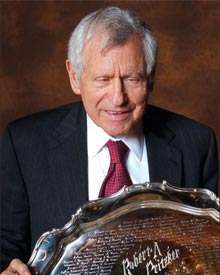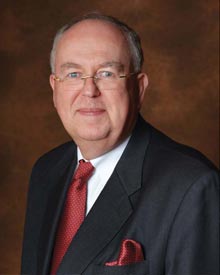Robert A. Pritzker (IE ’46)

Photo: Bonnie Robinson
In 1944, a fresh-faced 18 year old named Robert A. Pritzker enrolled at IIT for what he thought would be a semester or two break from California Institute of Technology. He’s been here ever since.
Pritzker has done just about every job possible at IIT during the past 62 years, earning a degree, returning to teach night classes to undergraduates, joining the Board of Trustees in 1962, and heading the board since 1990. That is to say nothing about the $60 million he and Robert Galvin each gave to the university in 1996—at the time, the largest charitable pledge ever made to a single institution in the Chicago metropolitan area.
Incoming Board Chair and Exelon Corporation Chief Executive Officer John W. Rowe invokes a lofty comparison when asked to evaluate Pritzker’s contributions to IIT.
“That’s like asking, ‘How do you assess George Washington?’” says Rowe, citing Pritzker’s years of service and judicious actions in stabilizing the university.
The foundation of Pritzker’s passion for the university was laid during his undergraduate career.
One of his highlights during that time was studying under Professor Herbert A. Simon, a 1978 Nobel Prize winner in economics. Pritzker always arrived early for classes with Simon, and often would be the last student to leave the classroom. “He got a kick out of me,” the soft-spoken Pritzker says, chuckling at the memory of his former professor.
More generally, Pritzker found that IIT was an excellent match for his ambition of going into manufacturing. “If you wanted to run a factory, you got a good education,” says Pritzker, who still works full time as chief executive officer of Colson Associates, Inc., a company that manages an international group of manufacturing and service companies. He has served as president of Colson since 1954.
After graduating from IIT in 1946, Pritzker taught evening courses for a few years in such subjects as statistical quality control. After being affiliated with other universities, he joined IIT’s Board of Trustees in early 1962.
Pritzker points with pride to the increased safety, the revamped and more attractive exterior of buildings, and the higher quality of students attending IIT during his tenure on the board. Despite taking pleasure in the gains the university has made, Pritzker feels strongly that more work remains to be done. He cites the need to upgrade the facilities inside the buildings, to recruit more star faculty members, and to boost IIT’s endowment.
Speaking at a tribute dinner in September, President Lew Collens said that Pritzker and Galvin’s challenge gift has had multiple positive consequences for IIT, including the establishment of the Camras Scholars program and several faculty chair programs, and the forging of a partnership with Chicago Mayor Richard M. Daley to invest in the neighborhood.
Collens also praised Pritzker’s “fierce commitment” to IIT, which was never more on display than in May 1995, when Pritzker taught a class at Oxford University, flew back to Chicago for a vital board meeting, and then immediately returned to Oxford in time for his next class.
Although relieved not to be spending quite as many evenings at IIT as he had during the past four decades, Pritzker says that he will miss the pleasure of interacting with professors and working with Collens. And, while he is glad to be passing the board chairmanship on to a man he sees as a worthy successor, Pritzker also made it clear that his commitment to his alma mater will not end anytime soon.
“I’m on the search committee for the new president, so they’ve already fixed that up,” he says, a broad smile creasing his face. “I had a meeting yesterday for about three hours, and I’ve got one next week, and there will be a dinner tomorrow.”
“So far, it hasn’t been a problem,” says Pritzker.
John W. Rowe

Photo: Bonnie Robinson
Incoming Board Chair John W. Rowe sees himself as a catalyst to help IIT move to its next stage of development.
“IIT is an institution with a stable educational core thanks to the leadership of Lew Collens,” says Rowe, chairman, president, and chief executive officer of Exelon Corporation, one of the nation’s largest utility companies. “This school is at a point where it needs some fresh vision from a leader who can start with the base that Lew built rather than the crisis Lew inherited.”
“Getting a higher sense of activity, participation, and meaning is one of the things that a board chair can do—I have lots of conversations,” Rowe says.
But Rowe does a lot more than talk.
One of Chicago’s most successful businessmen and renowned for his philanthropy, the 61 year old brings extensive professional and civic qualification to his new post.
Rowe’s leadership at Exelon has been widely recognized. In 2004, the company was named the top utility in Forbes magazine’s list of “The World’s 2,000 Leading Companies,” and in 2005 the magazine gave Exelon the same rank on its list of best-managed companies.
“Getting a higher sense of activity, participation, and meaning is one of the things that a board chair can do...I have lots of conversations.”− John W. Rowe
In addition to running the utility giant, Rowe has served on the board of trustees of more than a dozen prominent institutions, ranging from Northwestern University to the Art Institute of Chicago to the Northern Trust Company. He currently serves as chair of the Chicago History Museum.
Rowe also has a history of involvement with IIT.
Although he is not an IIT alumnus, Rowe worked with former Governor James R. Thompson as the vice chairman of the Mies van der Rohe Society, and then chaired the same group before joining the Board of Trustees.
Rowe’s blend of experiences attracted the attention of Collens and Pritzker, who asked Rowe to serve on IIT’s board more than two years ago, with an eye toward eventually asking him to assume the role of chair.
“He is somebody who has very broad intellectual interests—a very accomplished corporate leader who is extraordinarily well regarded in the Chicago community,” Collens says. “City leaders and philanthropists will all tell you that he is somebody very special.”
Rowe points out that he likes what he sees at IIT. “The College of Architecture is a great school, and Chicago-Kent College of Law has carved out a very productive niche for itself,” he says.
He adds that engineering and fields like physics and chemistry at IIT do not have a clear understanding of where they fit in the national research landscape: “Engineering and hard sciences are looking to say, ‘How do we compare to famous universities like MIT or Caltech? What is the IIT niche compared to, say, the University of Illinois?’”
“I think one of my tasks is to help IIT define the niche for its hard technology core,” Rowe says. This clarification process will not be conducted in isolation, he explains. Rather, it will happen through conversations with faculty, other board members, and Collens’ successor, whom Rowe will play a large role in helping to select—a task he says will be his “biggest contribution” to the university.
“The role of the chair is to help make certain we get a successor with vision,” says Rowe, who expects a replacement to be in place by the end of the academic year. “It’s the president who sets the vision. [I can] help to make [sure] that the executive committee and other board members can contribute to that vision.”
Rowe has the confidence of his predecessor as he begins an undertaking that will impact IIT for decades to come.
“To say that he’s very intelligent would be kind of obvious, but I believe he thinks deeply about things,” says Pritzker. “He’s an outstanding leader—very forceful, and correctly so.”
“I think we really lucked out on this one,” says Pritzker.